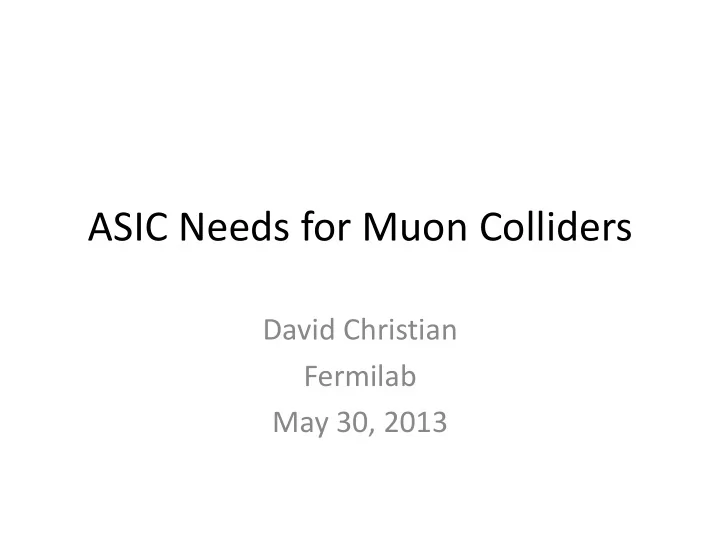

ASIC Needs for Muon Colliders David Christian Fermilab May 30, 2013
Muon Collider Motivation • Lepton colliders provide known initial state & calculable reactions. – Point particles – No strong interaction • Electron energy in a circular machine is limited by synchrotron radiation. – Goes like (1/mass) 4 – Muon mass is ~200 times greater than electron mass. – A circular machine with (multi) TeV beams is not ruled out and may be much less expensive than an electron linac. • Beam energy spread in any electron machine is limited by beamstrahlung. • Higgs coupling is proportional to mass. – H m + m - is enhanced by ~4000 with respect to e + e - – Muon collider Higgs factory could measure Higgs full width directly. 2
The Problem: Muons Decay • No easy source of muons to accelerate: – Need a high power proton accelerator to create enough muons to be worthwhile. – Need to “cool” the muons quickly before they decay ( t = 2.2 m sec). – Time dilation helps once muons are accelerated (lifetime in lab frame = gt ; g =E/m). • Beam lifetime determined by decays. – ~1000 useable turns (independent of E, since revolution time increases w/E (assuming same magnet strength), but so does g ). 3
The Problem: Muons Decay • Muons decay to electrons (& neutrinos). – Electron gets ~1/3 of muon energy • Electrons are swept to inner beam pipe by bend magnets. • They radiate synchrotron photons as they go (tangent to electron trajectory). • Photons interact with material, yielding neutrons – Designers talk in terms of decays/m (in 1 st turn) • 400,000 decays/m/bunch for 2.2E12/bunch @ 750 GeV • 5,000,000 decays/m/bunch for 2.2E12 @ 66 GeV (~equal power) – This is a problem both for the machine & for a detector. • Need to protect superconducting coils from heat load. • Need to worry about radiation damage and material activation in accelerator and in detector components. • Need to worry about background signals in detector. 4
Part of the solution: Shielding • Tungsten inserts (“nozzles” to stop gammas (generates neutrons). • Borated polyethylene cladding to absorb neutrons (+ concrete outside of detector). • Need to optimize! • Can reduce gamma flux by about a factor of 500. 5
Nikolai Mokhov@ 2011 Muon Collider Workshop: Total dose w/shielding • Maximum neutron fluence and absorbed dose in the innermost layer of the silicon tracker for a one-year operation are at a 10% level of that in the LHC detectors at the luminosity of 10 34 cm -2 s -1 Total dose ~1% of HL-LHC both for ionizing and non-ionizing radiation. 6
Detector Requirements • Instantaneous background rate is high since all backgrounds are concentrated in a small number of beam crossings (~10 kHz vs. 25 MHz for HL-LHC). • High granularity is required (to keep occupancies low) – ASICs can help control cost. • Very good time resolution is crucial. 7
Background is spread out in time Background in detector in 1 st turn – 1.5 TeV (Higgs Factory is similar) 8
Tight timing can greatly reduce background (Terentiev) 9
10
11
12
13
Timing is also key to calorimetry • Two studies have been done: – Pixelated digital calorimeter with 2ns “traveling wave gate” [R. Raja 2012 JINST 7 P04010] – Dual Readout Calorimeter with good timing (~10ns gate) [A. Mazzacane] 14
Summary • Muon Collider detector problems are dominated by background from muon decays. • With shielding, total dose requirement is non trivial, but much lower than HL-LHC (~1%) – probably still too high for COTS electronics. • High instantaneous background rate demands high detector granularity – ASICs can reduce cost. • Backgrounds can be greatly reduced ( very tight ) timing cuts. • Details will likely change as shielding strategy evolves. 15
Additional Slides 16
Much of the background in 1.5 TeV Collider is soft – dE/dx cuts in tracker can help Background in detector in 1 st turn (1.5 TeV CM) - Mokhov 17
Higgs Factory backgrounds are similar Background in detector in 1 st turn (125 GeV CM) - Stiganov 18
dE/dx in Layer 4 of SiD-style tracker Detector thickness Angled tracks dE/dX MIP neutrons Path in detector Compton electrons Background hits only (from Ron Lipton) 19
Recommend
More recommend